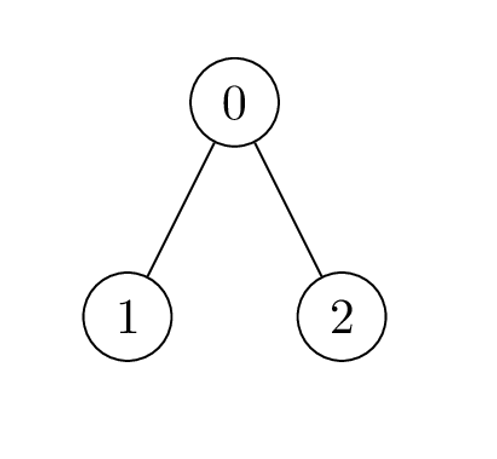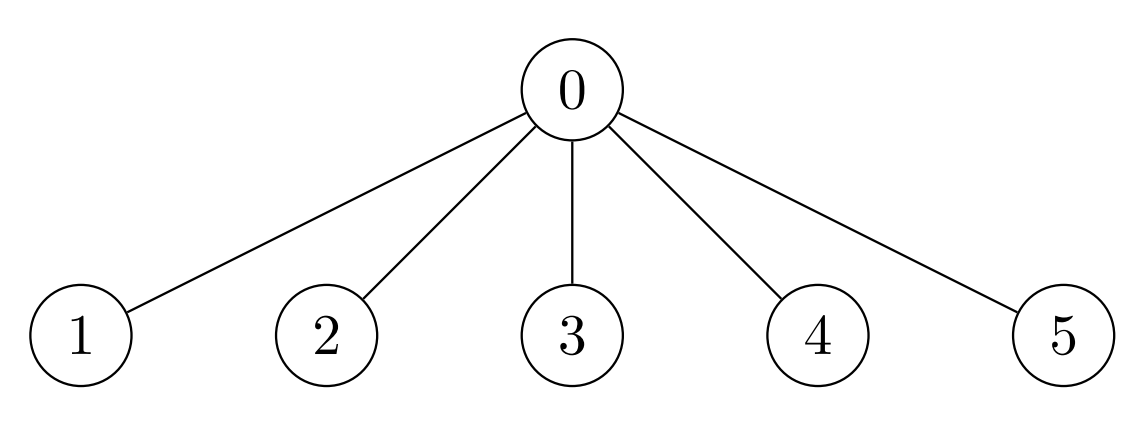最大节点价值之和
难度:
标签:
题目描述
There exists an undirected tree with n nodes numbered 0 to n - 1. You are given a 0-indexed 2D integer array edges of length n - 1, where edges[i] = [ui, vi] indicates that there is an edge between nodes ui and vi in the tree. You are also given a positive integer k, and a 0-indexed array of non-negative integers nums of length n, where nums[i] represents the value of the node numbered i.
Alice wants the sum of values of tree nodes to be maximum, for which Alice can perform the following operation any number of times (including zero) on the tree:
- Choose any edge
[u, v]connecting the nodesuandv, and update their values as follows:nums[u] = nums[u] XOR knums[v] = nums[v] XOR k
Return the maximum possible sum of the values Alice can achieve by performing the operation any number of times.
Example 1:

Input: nums = [1,2,1], k = 3, edges = [[0,1],[0,2]] Output: 6 Explanation: Alice can achieve the maximum sum of 6 using a single operation: - Choose the edge [0,2]. nums[0] and nums[2] become: 1 XOR 3 = 2, and the array nums becomes: [1,2,1] -> [2,2,2]. The total sum of values is 2 + 2 + 2 = 6. It can be shown that 6 is the maximum achievable sum of values.
Example 2:

Input: nums = [2,3], k = 7, edges = [[0,1]] Output: 9 Explanation: Alice can achieve the maximum sum of 9 using a single operation: - Choose the edge [0,1]. nums[0] becomes: 2 XOR 7 = 5 and nums[1] become: 3 XOR 7 = 4, and the array nums becomes: [2,3] -> [5,4]. The total sum of values is 5 + 4 = 9. It can be shown that 9 is the maximum achievable sum of values.
Example 3:

Input: nums = [7,7,7,7,7,7], k = 3, edges = [[0,1],[0,2],[0,3],[0,4],[0,5]] Output: 42 Explanation: The maximum achievable sum is 42 which can be achieved by Alice performing no operations.
Constraints:
2 <= n == nums.length <= 2 * 1041 <= k <= 1090 <= nums[i] <= 109edges.length == n - 1edges[i].length == 20 <= edges[i][0], edges[i][1] <= n - 1- The input is generated such that
edgesrepresent a valid tree.
代码结果
运行时间: 62 ms, 内存: 24.5 MB
/*
* 思路:
* - 给定无向树中的节点和边,以及一个整数 k。
* - 我们可以通过选择任意边来操作两个节点的值:nums[u] = nums[u] XOR k, nums[v] = nums[v] XOR k。
* - 目标是通过多次操作,使得所有节点的价值和最大化。
* - 由于 XOR 操作的性质,我们可以分别计算不进行操作时的价值和(sumOriginal),
* 以及每个节点 XOR k 后的价值和(sumXorAll)。
* - 最终的结果为 sumOriginal 和 sumXorAll 的较大值。
*/
import java.util.Arrays;
public class Solution {
public int maxSumAfterOperations(int[] nums, int k, int[][] edges) {
int sumOriginal = Arrays.stream(nums).sum();
int sumXorAll = Arrays.stream(nums).map(num -> num ^ k).sum();
return Math.max(sumOriginal, sumXorAll);
}
}解释
方法:
时间复杂度:
空间复杂度: